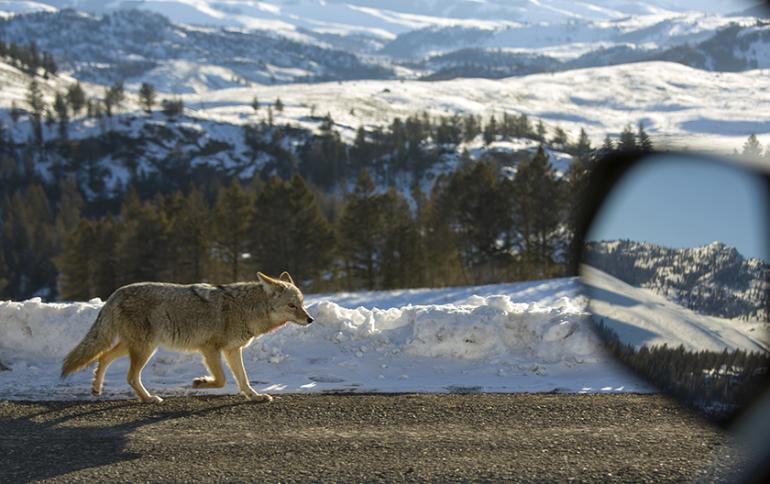A New Look at an Old Enemy
A crowd gathers near Soda Butte in Yellowstone National Park’s Lamar Valley. Four coyote pups playing outside their den have caused one of Yellowstone’s characteristic traffic jams. Observing these animals in a natural environment makes it difficult to regard them as pests, yet outside the park they are one of the country’s most vilified predators—the subjects of intense eradication programs in place for nearly 100 years. But unlike other carnivores, coyotes have responded to predator control programs by increasing their numbers and extending their ranges. Has the time finally come to reevaluate our actions and attitudes toward coyotes? After almost a century of wasted effort, perhaps it is time to learn to coexist with these creatures, rather than fight a losing battle to eliminate a supposed pest.
In 2004, USDA’s Wildlife Services exterminated more than 75,000 coyotes. Tens of thousands more die each year at the hands of private citizens, most in the name of livestock protection. But these efforts are proving ineffective, even counterproductive. Since predator control became an official, federally funded program in 1915, coyote populations have flourished and extended beyond their historical ranges. The crafty canines have even been spotted in urban areas such as Boston and the Bronx.
Research suggests that rather than being a solution, lethal control creates a scenario more likely to result in coyote-livestock conflicts. A 1999 publication by Bob Crabtree and Jennie Sheldon, of the Bozeman-based Yellowstone Ecological Research Center, points out how disintegration of pack dynamics due to lethal control can result in a larger population more apt to prey upon livestock.
In Yellowstone National Park, a habitat with no human-caused mortalities, Crabtree and Sheldon found that only alpha females (36% of the female population) reproduced successfully. Pack size averaged six animals, consisting of an alpha breeding pair and non-breeding betas. Additionally, pup survival was around 30%.
Conversely, coyotes in habitats with high human-caused mortalities (>50%) showed little to no pack structure. Without alpha/beta pack dynamics, a larger percentage of the population breeds, many at younger ages. Paired with a higher pup survival rate of over 70%, populations in highly disturbed habitats can be expected to grow despite intense lethal control efforts. Furthermore, without beta pack members to help provide for pups, coyotes in this population are more likely to take larger, non-natural prey such as calves or sheep, and skills for hunting natural prey are not passed on to young coyotes.
David Gaillard, of the Bozeman-based Predator Conservation Alliance, describes this effect as “demographic compensation.” In essence, by killing coyotes indiscriminately and breaking apart their social structure, we have removed nature’s inherent control over coyotes’ high fecundity and dispersal rates.
In addition to compounding the problem it attempts to solve, lethal control is far from economically sound. Wildlife Services data from past years shows that the cost of killing predators is three times greater than the damage they incur on livestock. According to the National Agricultural Statistics Service (NASS), Wildlife Services spent over $101 million in 2004, with a large percentage going towards lethal control of coyotes. One wonders why more of that budget is not spent on alternative controls, or even a livestock compensation fund similar to that in place for wolf depredations.
Wildlife Services data shows that nearly 43% of coyotes taken were shot from planes or helicopters—an incredibly high-cost method of eradication. Gaillard appropriately asks, “In a free market economy, would this occur?” Yet it continues—most likely because it is subsidized by taxpayers.
So beyond simple admiration for the coyote, there are strong economic reasons to eschew lethal control. Thankfully, many options abound, such as electric fencing, frightening devices, and guard dogs, with combinations of these and other methods being the most effective. In short, solid husbandry practices may be the most effective way to prevent coyotes from taking livestock.
In all fairness, ranchers should be commended on the steps taken thus far. NASS data states that sheep ranchers, the primary victims of coyote depredations, spent $9.8 million on non-lethal control methods in 2004. These methods can also be costly, but provide more long-term benefits than lethal control. Continuing non-lethal controls in place of lethal ones will allow coyotes to restore social hierarchies, and nature’s management will eventually replace most human controls.
Crabtree adequately sums up the appeal as well as the problem of coyotes with this compliment: “They are great survivors! Humans try and try to get rid of them but it rarely works, and when it does it costs lots and lots of money.” Hopefully we are progressing to a place where we deal with the roots of the coyote/livestock problem, rather than pruning branches that will return and multiply. Our actions have made the coyote a victim of its own success, but a trip to Yellowstone to watch these animals in their natural environment may yet confirm the proper course of action.






